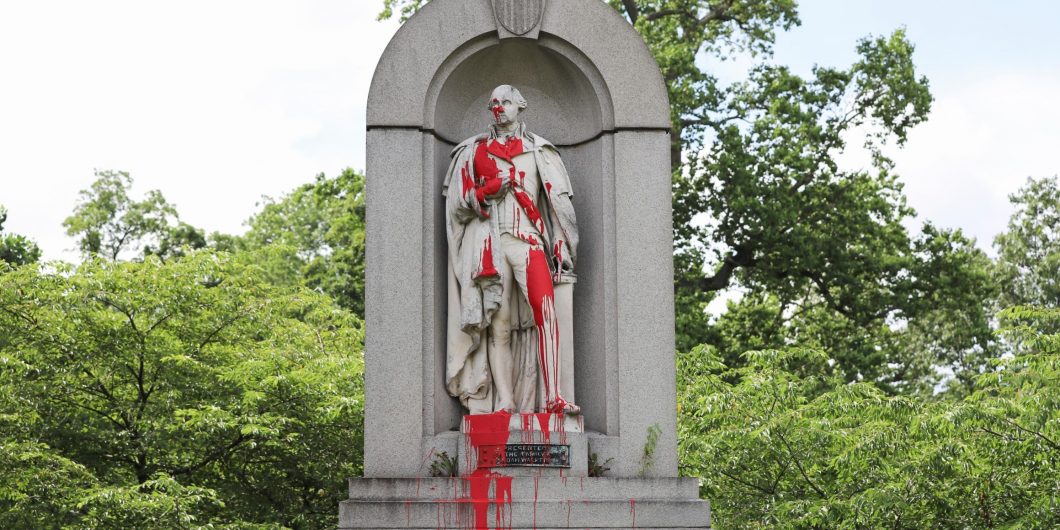The Emancipation Memorial's depiction of Archer Alexander is powerful not just for his physicality but because he has the force of right behind him.
Destroying Monuments—and Constitutions
John Ruskin once said that “great nations write their autobiographies in three manuscripts: the book of their deeds, the book of their words, and the book of their art.” Unfortunately, our most public book of art—the statues and monuments that record our deeds—is being shredded. What began as the vandalization and destruction of statutes related to the Confederacy has become a more general assault on icons from Columbus to the Founders to abolitionists.
Institutions and places that serve historical memory have also been separated from their former names. Woodrow Wilson no longer graces the public policy school at the university at which he was president before becoming U.S. President. Washington and Lee likely will soon become Washington University and perhaps even Washington will disappear. And as Josh Blackman notes, the two law schools named after Chief Justice John Marshall are considering jettisoning the name of the justice assessed as the greatest by the consensus of legal historians.
These stirs have not been unique to the United States. David Hume’s name has been removed from a tower at the University of Edinburgh, despite his being that university’s most illustrious graduate. During his life, he was denied a professorship because of his atheism, and now a more recent religious enthusiasm wants to dishonor him anew. Amusingly, the building now reverts to commemorate George III, a king who opposed getting rid of the slave trade and had a few other flaws, perhaps better recognized on this side of the Atlantic.
Monuments and public memorials have a family resemblance to constitutions, the most important book of words for any great modern nation. Like monuments, constitutions celebrate the core values of society. Unlike the passing debates of ordinary politics, constitutions are to endure and link the present to the past. Both memorials and constitutions embody what Burke meant when he said that a society is the “partnership. . . between those who are living, those who are dead, and those who are to be born.” And, like a constitution, memorials use a historical moment to provide ballast against both passing whims and weighty ideas that may have a delusive plausibility but soon dissipate. A constitution is designed to protect Peter Sober against Peter Drunk. But public reverence and gratitude for the great and good of the past may help prevent us from getting drunk in the first place.
And like constitutions, monuments and memorials have similar enemies—impassioned crowds and elites that want to bypass the appropriate political processes, sometimes working separately and sometimes together. Mobs riding a wave of protest inspired by Black Lives Matter recently destroyed a statue of George Washington in Portland and many others. They did so to express their view of present injustices, heedless of the harm it did to the fabric of society. But sometimes elites were complicit too. Portland’s Mayor Ted Wheeler has created a culture of impunity that empowers mobs to vandalize monuments. When a statute of an elk that memorialized Portland’s relation to the pristine West was vandalized, he had it removed rather than restored. In my own city of Chicago, Mayor Lori Lightfoot refused to defend statues of Christopher Columbus against protestors. Instead, she ordered them taken down in the dead of night without any vote of the city council.
There is thus a broad similarity between the way constitutional provisions and monuments are wrongly discarded. In constitutional law, social movements, like those in favor of abortion or same-sex marriage, argue that the provisions of the old Constitution must be rejected insofar as they stand in the way of recognizing some new value. A few elite justices on the Court ratify its victory in constitutional law. Lest one think that this is too cynical a description of the way constitutional law gets made, some law professors celebrate social movements and their elite blessing at the Court as a sound process of constitutional fabrication.
A deliberative process for reconsidering memorials tempers polarization and is likely to lead to more principled decision-making about which memorials to take down.
This method of making law permits judges to determine which social movements get to modify the Constitution, thus creating political polarization and a sense of alienation from those who do not agree with the favored movements. The better way of making constitutional law is through the amendment process of Article V that requires substantial and lengthy debate and ultimately consensus before adding to or subtracting from our fundamental law.
And a similar, broadly democratic process should be used for removing and adding memorials. It is true that some people may no longer seem worthy of public honor given new discoveries about their lives or new views of what is honorable. But just how dishonorable their actions were and how those actions should be weighed against the totality of the lives is best determined by a more deliberative process than can be afforded by angry crowds or by a few political actors seizing the crisis to make political points.
A deliberative process for reconsidering memorials also tempers polarization that ensues from the disappearance of monuments that have represented some people’s values for as long as they can remember. The debate also is likely to lead to more principled decision-making about which memorials to take down. For instance, some statues that no one wants to take down are of men, like Martin Luther King, who did great things yet had substantial flaws that are clearer to us in the present day than they were at the time they were erected. Deliberation forces us to consider principles that should apply to the maintenance of all memorials. It is likely to lead us to the sensible position that we should not destroy or remove memorials to people when they were erected to help us remember the sound principles they embodied, even if they had personal flaws.
Universities too should try to engage all their constituencies and not just give into the most fanatical students before renaming venerable parts of their institutions. A university is not just for current students and faculty, but also for the alumni who are nurtured by it and then support it. Moreover, alumni bring a greater range of perspectives than can be found in youthful students and insular professors.
Of course, there are memorials, like some Confederate ones, that were erected to honor figures who did not improve the nation. Moreover, some of these memorials have a problem that also resembles a problem with our original Constitution: when the decision was made to build them, African Americans were largely excluded from the process. And it is not just an acute problem. As Mike Rappaport and I have noted, our original constitutional failure has been followed by constitutional correction through the amendment process. Everyone now has the same civil rights as the adults who framed our fundamental law. But there has not been a sufficient correction for the exclusion from a decision to put up monuments to those who fought at least in part to keep those excluded as slaves.
Nevertheless, it would be prudent to engage in the same full democratic deliberation before taking down monuments even to the Confederacy. African Americans can now fully participate in that process and the deliberation respects the attachment of some to monuments to their ancestors. Moreover, this process will help us embrace principles that prevent the wholesale burning of our public book of art and memory.


